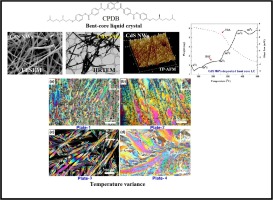

Reliable optoelectronic switchable device implementation by CdS nanowires conjugated bent-core liquid crystal matrix
Enhancing the performance of high luminescent and dielectrically capable cadmium sulfide nanowire (CdS NW) is of great importance, because of their promising ability in analyzing the dimensionality and size. The tuned physical characteristics of semiconductor CdS NWs allowed the manipulation of both electronic and optoelectronic devices at the nanoscale by dispersing a new bent core (BC) liquid crystal (LC) compound. This was derived from a 4-chlororesorcinol central core unit with two terephthalate based rod-like units carrying chiral (S)-3, 7-dimethyloctyloxy (namely ‘CPDB’) terminal chains, which have been synthesized in a pure solvo-chemical process. The mesomorphic properties of the newly-prepared bent-core LC, exhibiting an enantiotropy ‘Sm A’ phase as a result of dispersing 0.005% of CdS NWs, were investigated by several spectroscopic investigations. In addition, the hydrothermal fabrication of CdS NWs with a high-yield was modified with a cationic agent, cetyltrimethyl ammonium bromide (CTAB), which was utilized as a compatibilizer for providing a better interaction with LC molecules and giving a homogeneous solution. This work focused on the experimental investigation and optimization, using a combinational view of bent-core liquid crystal (CPDB) compound dispersion which was achieved in a controllable manner. The product of the resulting composite matrix has a very outstanding and promising behavior, e.g. semiconductor nanostructures emission polarization that can be manipulated using an external bias modulation of the novel switchable device, which was found quite convincing in the recent trends of brand-new technologies. In particular, the electro-optic responses by POM of various mesophases were investigated from the view point of the CdS incorporated bent-core LC matrix formation and transitional phase variants of ‘ON’ and ‘OFF’ states, which were depending on the geometrical parameters of CdS NW's. Finally, the future challenges and prospects of any other nanomaterials dispersed into CPDB compound which will give rise to an increase of the mesomorphic range by preserving the mesophase type were explored in detail. © 2019 Elsevier B.V.



